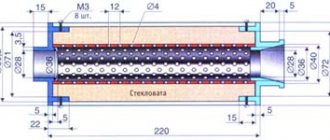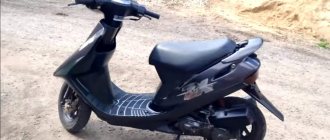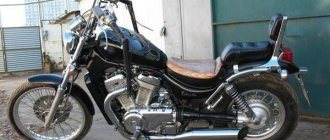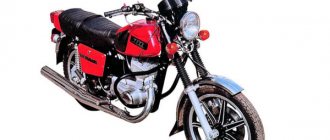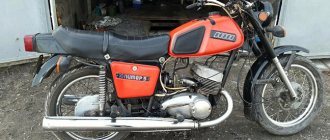The legendary Java 350 motorcycle is the dream of every motorcyclist of the late 20th century. Not a single Soviet motorcycle could compare with the quality of workmanship and smooth running of the Java. The particular popularity of Czechoslovakian technology is still relevant today. Naturally, every owner wants to improve the characteristics of the model, and the topic of today's article is Java tuning. In it we will look at what Java 638 tuning is, how to achieve better performance from the engine and create a modern appearance with your own hands. Let's find out how the Java 634 tuning differs from the 638 model and which is better.
Tuning Java 350 let's start with the engine. Clean the engine thoroughly from dust and oil to prevent dirt from getting into the engine. Having completely disassembled the engine, carry out a complete inspection for wear. It is recommended to immediately replace the bearings with new Japanese ones, since only they can cope with the increased speed and increased power when tuning the engine. Keep in mind that boosting the motor is a serious matter; at least turning, a grinding tool, and preferably a drill to change the purge channels will be required. The factory shape of the channels provides traction at low and medium speeds, which is done in order to save fuel. By slightly boring the cylinder bores a few millimeters in height, you can increase the engine speed and, accordingly, its power. To improve purging, be sure to align the channels of the lower plane of the cylinder with the upper plane of the crankcase; steps and protrusions that will interfere with the flow are not allowed. Also sand down any irregularities in the intake and exhaust ports until they are smooth. Then we move on to tuning Java 638 cylinder heads. To do this, having secured the heads in a lathe using a mandrel, cut them with a cutter by 1.5-2 mm, due to which the combustion chambers will decrease and the compression ratio will increase. If you have a Java 634, tuning the pistons consists of making them lighter; to do this, the jumpers of the lower piston skirt are cut off, and the free space under the piston will ensure the unhindered flow of the fuel mixture. Tuning Java 638 is more preferable because it has aluminum cylinders that can withstand boost much better and effectively remove heat.
The power supply system is very important for a two-stroke motorcycle. The filling of the cylinders and power depend on the quality of mixing of fuel with air. Reed valves also play a huge role in this system. It allows the fuel mixture to be admitted when the piston is sucked in, and does not allow the mixture to be pushed back, thereby improving engine performance. Reed valves can be selected from any other two-stroke motorcycle of similar capacity. A photo example is shown below:
The efficiency of tuning Java 638 can be significantly increased by dividing the intake channels into two separate ones for each cylinder with its own carburetor.
One standard carburetor is not able to fully cope with its task and significantly chokes the engine in terms of speed. Installing crossover carburetors from Mikuni or Keihin with a diffuser size of 28mm will radically change the behavior of the engine. You can read how to set up a Java carburetor here.
Exhaust system improvement
Another significant thing in tuning the Java 350 is the exhaust system. Unlike a 4-stroke engine, in a 2-stroke engine the cylinder is filled by purging the cylinder. With a properly assembled resonator, a fresh fuel mixture effectively fills the cylinder, and due to the conicity of the resonator, the sound wave is reflected. Thus, part of the mixture does not fly out into the pipe, but returning to the cylinder gives up to 20% more power. You can weld such a resonator with your own hands from sheet steel 0.6-0.8 mm thick, and argon or semi-automatic welding is recommended. The exhaust pipe of the resonator can be made by shortening the standard one by increasing the cone according to the drawing:
According to the figure, the engine will have a sharp pickup and increase in power around 5000 rpm. The damping nozzle is not necessary and only performs a noise-absorbing function. As with tuning the Voskhod motorcycle, this resonator can be used in the same way.
The significant mass of the crankshaft has high inertia, which is done for smooth operation of the engine. By lightening it, you can achieve a sharp response to gas and improved acceleration dynamics. Keep in mind that with this modification of the engine, it is extremely reluctant to operate at idle and low speeds. And of course, don’t forget about replacing the ignition from a contact system to an electronic microprocessor system.
Improved appearance and safety
Think about safety first. Standard rims, and even more so drum brakes, are not able to cope with the increased power. It is recommended to install a good disc brake along with replacing spoked rims with alloy wheels. This will not only give a modern look to your bike, but will also significantly improve stability on the track. Accordingly, improved rims from another motorcycle are designed for greater braking force and have normal mounting for the brake disc. Good road tires are also a must.
Replacing headlights and other outdated lighting equipment will appeal to everyone. And the dashboard can be easily transformed by installing LED strip lighting.
The standard steering wheel can be easily replaced with clip-ons or a straight-shaped steering wheel, which will somewhat improve the driver’s aerodynamics due to the inclined seating position. Installing wind deflectors is no longer in fashion, as in Soviet times; they create too much air resistance in front of them. Much preferable is a sports body kit, which, depending on the financial investment, can be picked up from any other motorcycle, but if you really want to make it yourself from fiberglass and epoxy resin. Tuning a Java motorcycle in the photo:
And finally, we want to say that a forced engine requires good 2-stroke oil and timely maintenance. Java tuning is a fascinating activity that requires imagination and direct hands. If you follow the tuning technology, the result will not leave you indifferent
The Czechoslovak legend Java 350, from the very beginning of its production in 1970, immediately attracted the attention of motorcyclists throughout the USSR. The agile and maneuverable unit differed from its counterparts in its high load capacity (up to 200 kg), an improved two-stroke engine, reliable disc brakes and a progressive appearance for that time.
Time does not stand still, and in order for the favorite of generations to keep up with modern models, the owners are ready to resort to the most radical changes in its design.
In conclusion
To improve the performance of their two-wheeled “iron horse” and give it a second life, many owners use tuning. “Java 350” is a quite decent motorcycle, but in design and parameters it no longer reaches modern models. Modernization allows you to make fundamental changes to the design, resulting in a car whose owner will be the envy of everyone around you.
It is quite possible to remake the equipment yourself. Properly performed restyling will not only transform the motorcycle, but also make it a unique bike. The main thing is to stock up on the necessary materials, theoretical knowledge and patience.
Previous entry Motorcycle repair and maintenance
Sports option
Tuning for sports, due to the technical features of Java, is the most common way of modifying it.
Basic requirements for sports motorcycles:
- Maximum speed.
- Acceleration speed.
- Controllability.
- Safety.
- Convenience.
One of the obvious disadvantages of the Java 350 is considered by many to be too light a front end, which begins to lose traction at high speeds. Therefore, despite the need for a general lightweight design, when installing a sports front fork, it will not be superfluous to place a counterweight. Changes to the chassis also include the installation of disc brakes, alloy wheels and a more wear-resistant chain from IZh motorcycles.
The performance characteristics of the Java 350 are largely relevant to this day, but the modernity of its design is a big question. The simplest option for external tuning for sports is to install parts from the Yamaha FZR400 and Kawasaki KR250 on a motorcycle. The first option is an excellent donor for the front wing, the second - for wheels, front forks and brakes, rear shock absorber and pendulum.
The last part for installation in the Java socket must be narrowed by replacing the standard bearings with needle bearings from the Volga pins. The combination of these innovations makes the motorcycle more maneuverable, stable and controllable. Body kits are made to order, both in workshops and by “home” craftsmen. Do-it-yourself external tuning of Java is also not uncommon. To do this, it is enough to be attentive and careful, and also to have a sufficient amount of plastic or fiberglass with you.
What can be tuned in Dnepr?
At the time these motorcycles were released, their quality was at the highest level, so all the components and the design itself still actively serve all owners. But modern requirements for appearance and some technical characteristics force us to carry out cosmetic and internal modifications to the motorcycle. Of course, you can do the tuning of the Dnieper with your own hands, but if you don’t have enough knowledge, workshops are open in most cities where people are probably knowledgeable in modernizing Soviet motorcycles.
There are basic elements that need to be changed when tuning, and in this model the following elements can be improved or even replaced:
- exhaust pipe;
- almost the entire chassis, in particular the windshield, roll bars;
- engine;
- front fork.
You can also briefly discuss the refinement of each element. For example, to tune the exhaust system, you will need to install a forward flow system and nickel elbows, which you can do yourself. External tuning will contain a lot of chrome parts, so tuning the Dnepr engine will involve a polishing process. If you upgrade these two parts, your motorcycle will not only look great, but it will also sound great.
As for technical modernization, the above recommendations can be supplemented by installing a fifth gear on the Dnepr. It is unlikely that you will be able to do this kind of work yourself, so it is better to turn to specialists with experience. But the result will be justified; your vehicle will have reverse gear. But even this is not where the basic tuning ends, because some Dnepr models, depending on the year of manufacture, can be improved by installing an electric starter.
Engine tuning Java 350
The first thing the owners of the “old lady” strive for is improving its speed performance. A common misconception in this regard is the need to equip a motorcycle with a 5-speed gearbox . Its installation can be partially justified only if the chassis and engine are modernized. Boosting the engine is a guaranteed increase in maximum speed and acceleration, but there are a couple of nuances here. Firstly, boring the cylinders leads to a decrease in the thickness of their walls, and, consequently, to an increase in heat transfer, which entails a loss of compression and possible jamming.
Secondly, forcing implies the combustion of more fuel in one cycle, which means increased fuel consumption and thermal stress of parts.
Addition
Tuning Java 350 very often affects the exhaust system. Despite contraindications from specialists, many owners install forward flow systems made from VAZ 2131 mufflers on this motorcycle; 21213; 21214. The part of the pipe leading to the engine is cut 5 cm from the muffler itself, and the part going out is bent at the required angle. When connecting to the elbow, the pipe is slightly cut and pressed tightly. The body mount is first welded to the forward flow, and a footrest is finally mounted on the motorcycle itself.
A tachometer will add to the presentation and functionality of the unit. Its connection is made according to the same parameters as in the car. Installing a starter on a Java 350 is a rather complicated procedure, but quite realistic. It requires a flywheel change, additional mounting on the body and a reinforced battery.
Motorcycle lighting is another characteristic manifestation of sports tuning. LEDs, the color of which can either emphasize the color of the device or be in contrast with it, illuminate key design components: the engine, exhaust pipe, rims.
Correctly performed tuning can not only transform your two-wheeled friend, but also significantly improve its technical parameters, making the motorcycle the envy of surrounding motorcyclists.
Java is a dream motorcycle of the 70-80s of the last century. IZH, Voskhod, Minsk, even the powerful Ural, all this is not the same in comparison with the only imported motorcycle widely available to the Soviet motorist - Java. And even though this is not a bike from the decaying, but technically more developed West, but an import from a country party to the Eastern Treaty, Czechoslovakia, at that time, was ahead of the USSR in the quality and technical perfection of the motorcycles produced. Java was perhaps the best thing that a Soviet person could acquire for himself back then, and the motorcycle deservedly became a real legend for several generations.
1970 The Java 350 model is entering the market. A powerful, maneuverable motorcycle with a load capacity of 200 kg, a two-stroke engine, disc brakes, and a fashionable and sporty appearance. Java is completely different from other models available on the market. Soviet motorcycles of that time were not far removed in their technical characteristics and appearance from the German models of the 40s, on the basis of which mass production of domestic motorcycles was launched using equipment exported from Germany. Owning a Java motorcycle was considered prestigious, fashionable, and simply a must for anyone who wanted to keep up with the times.
Features of electrical equipment
In many respects, the components and assemblies of the Czech motorcycle were similar to domestic products, but at the same time they differed:
- high quality;
- amazing wear resistance;
- maintainability and long service life.
In those years, Java motorcycles were in short supply, so they were often sold second-hand. And at the same time, the price remained quite high. New owners could immediately get behind the wheel and operate the equipment without any restrictions, because:
- wiring to Java did not require maintenance;
- the engine had a significant service life;
- shock absorbers and suspension had a fairly high safety margin;
- consumables were required no more often than provided for by the technical regulations.
Repair instructions for Java motorcycles officially supplied to the USSR
However, the manufacturer constantly modernized its motorcycle models, and each time made changes to components and assemblies. In particular, in different years the following were supplied to the territory of the USSR:
- model 559-07 was produced since 1969 under the name “JAWA 250” and was a variant with a 250 cc engine producing 12 hp. with 6V equipment;
- model 634 (01-04) was produced from 1973 under the name “JAWA 350” and represented a variant with an increase to 350 cc. cm 16 hp motor, designed to work with 6V equipment;
- model 634 (01-08) was produced since 1977 under the name “JAWA 350”, but already with 12-volt equipment and on 16-inch wheels;
- Model 638 has been produced since 1986 under the name "JAWA 350". It had only visual differences in the shape of the frame and was equipped with 18-inch wheels (see wiring diagram for Java 638);
- Model 640 was the last modification that was officially supplied to our country. It was also designed to operate 12-volt equipment and had differences in design and suspension.
Original wiring diagram for Java 12V model 638
Equipment 6W
For the first 8 years of deliveries from Czechoslovakia, JAWA motorcycles were equipped with equipment designed for a current of 6V.
Original color diagram of electrical equipment Java model 634
There are differences in the above diagram due to modification. In particular, the JAWA 634.8.00 model does not have:
- direction indicator warning lamp;
- neutral control lamp in the gearbox;
- breaker capacitors.
Subsequent motorcycles had these electrical parts installed at the factory. And domestic craftsmen independently equipped their “iron horses” using a new scheme.
Differences in voltage were not an obstacle for owners, who often independently converted the motorcycle’s power supply from 6V to 12V. This required:
- replace the generator with a new six-pole one with a self-excitation system of electric current, which made it possible to operate the motorcycle with a completely discharged battery;
- replace incandescent lamps with more powerful ones;
- install contactless electronic ignition;
- replace high voltage wires.
Equipment 12W
Later, the manufacturer recognized the promise of 12-volt equipment and began to equip its products with it. Thereby:
- electronic ignition appeared on motorcycles;
- changing the generator circuit made it possible to operate the vehicle without a battery (during the daytime);
- The luminous flux of the headlights has increased and the brightness of the side lights has increased.
Original photo of the electrical circuit of the model 640 in Czech.
Features of the 12-volt equipment include a bipolar turn relay, which has not previously been found on motorcycles. Its operation scheme is based on the principle of the difference in the current consumption of the control lamp (6W) and the direction indicator lamps (21W):
when turning on the right turn, “+” from the generator or battery enters the right turn circuit, passing through the terminals of the bipolar relay;
- in this case, current is supplied to the right front and rear right turn signal lamps;
- The indicator lamp is directly connected with one contact to the right turn circuit, and the other to the left turn circuit. When the right turn is turned on, “+” is supplied to the control lamp, and “-” appears in the left circuit of the control lamp for the other contact, coming through the filament of the left lamp of the turn circuit (see also the Java 350 wiring diagram).
Let's start tuning the Java 350 motorcycle with our own hands
The happy owners of the Java motorcycle traveled along the roads of the Soviet Union for more than twenty years. And to this day, many of our fellow citizens can find an old Java 350/638 in their garage. This motorcycle, already a classic, not only brings back nostalgic memories, but also still fulfills its main function of transporting people.
But time passes, the demands of motorcycle owners are growing, and the old Jawa, alas, is not getting any younger. Motorcycle tuning required . Which tuning is best for Java? – it’s up to you to decide. Let's try to update our old Java, give it dynamics, improve its characteristics, and update its appearance. Tuning a Java motorcycle is relatively simple, and can be done by any car enthusiast who has the appropriate technical skills and wants to do the tuning of his favorite motorcycle on his own.
Sports tuning Java
Where to start tuning Java? The design features of the motorcycle make sports tuning the most preferable option for improving your old Soviet Java 350. To improve driving characteristics and stability, modern motorcycle tuning includes the following points:
- Replacing the front fork with a sports one with the placement of a counterweight to weigh down the light front part, which is too shaky at high speeds.
- Installing alloy wheels and replacing the drive chain (possibly with a stronger chain from an IZh motorcycle).
- You can improve the appearance and characteristics of the Java 350 by installing, for example, a front fender from a Yamaha FZR400 motorcycle, and wheels, a front fork, a rear shock absorber, a swingarm and brakes from a Kawasaki KR250.
What else can be improved?
Some owners improve the exhaust system of the Java motorcycle. Tuning, the photo of which is presented below, is performed by installing direct flows from the mufflers of VAZ cars. The pipe leading to the engine is cut fifty millimeters from the muffler itself, and the outer part is bent at a certain angle. To connect to the elbow, the pipe is cut and installed securely. First, body clamps are welded into the forward flow, and a kickstand is installed on the bike.
The tachometer taken from the VAZ-2106 adds additional aggressiveness and presentability to the two-wheeled unit. It is connected identically to the connection diagram in the car. To install a new starter on a Java, you will need to replace the flywheel, install an additional housing mount and a reinforced battery.
A good innovation would be to change the lighting of the motorcycle. You can choose LEDs to match the color of the unit or play with contrast. The lighting of the rims, exhaust pipe, engine and other main components of the device will look original.

